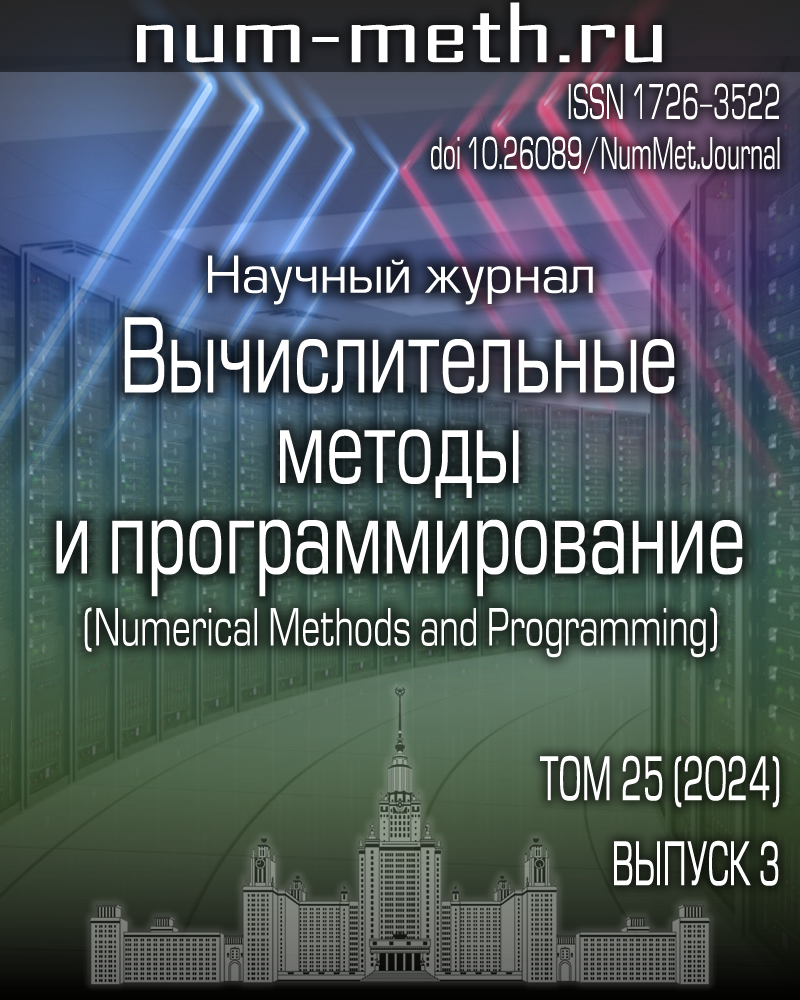DOI: https://doi.org/10.26089/NumMet.v25r327
Адаптивные шаги по времени для агрегационно-фрагментационной кинетики
Ключевые слова:
Аннотация
Мы предлагаем экспериментальное исследование методов интегрирования по времени с адаптивными шагами по времени для эффективного моделирования кинетики агрегации-фрагментации. Точное моделирование этого явления обычно требует использования больших систем нелинейных обыкновенных дифференциальных уравнений и интенсивных вычислений. Мы исследуем производительность трех явных методов Рунге–Кутты и проводим моделирование для двух типов задач: нахождение равновесных решений и моделирование для кинетики с периодическими решениями. Первый класс задач может быть проанализирован посредством релаксации решения к стационарному состоянию на больших временах. В этом случае адаптивные временные шаги могут помочь достичь этого состояния с использованием больших шагов, снижая стоимость вычислений без потери точности. Во втором случае задача оказывается численно неустойчивой в определенных точках фазового пространства и может потребовать крошечных шагов, что делает моделирование с постоянными шагами очень трудоемким. Адаптивные критерии позволяют увеличить шаги для большинства оставшихся точек и значительно ускорить моделирование.
Опубликован
Выпуск
Раздел
Библиографические ссылки
- P. L. Krapivsky, S. Redner, and E. Ben-Naim, A Kinetic View of Statistical Physics (Cambridge Univ. Press, Cambridge, 2010).
doi 10.1017/CBO9780511780516 - A. E. Aloyan, V. O. Arutyunyan, and A. N. Yermakov, “Dynamics of Gas Admixtures and Aerosols in Forest and Peat Fires,” Rus. J. Num. Anal. Math. Model. 29 (2), 79-92 (2014).
doi 10.1515/rnam-2014-0007 - M. V. Smoluchowski, “Versuch einer Mathematischen Theorie der Koagulationskinetik Kolloider Lösungen,” Zeit. Physikalische Chemie 92U (1), 129-168 (1918).
doi 10.1515/zpch-1918-9209 - A. A. Lushnikov, “Evolution of Coagulating Systems: III. Coagulating mixtures,” J. Colloid Interface Sci. 54 (1), 94-101 (1976).
doi 10.1016/0021-9797(76)90288-5 - F. Leyvraz, “Scaling Theory and Exactly Solved Models in the Kinetics of Irreversible Aggregation,” Phys. Rep. 383 (2-3), 95-212 (2003).
doi 10.1016/S0370-1573(03)00241-2 - K. Kang, S. Redner, P. Meakin, and F. Leyvraz, “Long-Time Crossover Phenomena in Coagulation Kinetics,” Phys. Rev. A 33 (2), 1171-1182 (1986).
doi 10.1103/PhysRevA.33.1171 - J. B. McLeod, “On an Infinite Set of Non-Linear Differential Equations,” Q. J. Math. 13 (1), 119-128 (1962).
doi 10.1093/qmath/13.1.119 - S. Kaushik and R. Kumar, “Steady-State Solution for Discrete Oort-Hulst-Safronov Coagulation Equation,” Int. J. Dyn. Syst. Differ. Equ. 13 (2), 144-163 (2023).
doi 10.1504/IJDSDE.2023.130311 - S. A. Matveev, A. P. Smirnov, and E. E. Tyrtyshnikov, “A Fast Numerical Method for the Cauchy Problem for the Smoluchowski Equation,” J. Comput. Phys. 282, 23-32 (2015).
doi 10.1016/j.jcp.2014.11.003 - S. A. Matveev, A. A. Sorokin, A. P. Smirnov, and E. E. Tyrtyshnikov, “Oscillating Stationary Distributions of Nanoclusters in an Open System,” Math. Comput. Model. Dyn. Syst. 26 (6), 562-575 (2020).
doi 10.1080/13873954.2020.1793786 - S. A. Matveev, P. L. Krapivsky, A. P. Smirnov, et al., “Oscillations in Aggregation-Shattering Processes,” Phys. Rev. Lett. 119 (26), Article Number 260601 (2017).
doi 10.1103/PhysRevLett.119.260601 - N. V. Brilliantov, P. L. Krapivsky, A. Bodrova, et al., “Size Distribution of Particles in Saturn’s Rings from Aggregation and Fragmentation,” Proc. National Academy of Sci. 112 (31), 9536-9541 (2015).
doi 10.1073/pnas.1503957112 - A. I. Osinsky, “Low-Rank Method for Fast Solution of Generalized Smoluchowski Equations,” J. Comput. Phys. 422, Article Number 109764 (2020).
doi 10.1016/j.jcp.2020.109764 - A. I. Osinsky and N. V. Brilliantov, “Exact Solutions of Temperature-Dependent Smoluchowski Equations,” J. Phys. A: Math. Theor. 55 (42), Article Number 425003 (2022).
doi 10.1088/1751-8121/ac971b - M. A. Larchenko, R. R. Zagidullin, V. V. Palyulin, and N. V. Brilliantov, “Application of Machine Learning Technique for a Fast Forecast of Aggregation Kinetics in Space-Inhomogeneous Systems,”
https://arxiv.org/pdf/2312.04660 . Cited September 10, 2024. - M. Smith and T. Matsoukas, “Constant-Number Monte Carlo Simulation of Population Balances,” Chem. Eng. Sci. 53 (9), 1777-1786 (1998).
doi 10.1016/S0009-2509(98)00045-1 - F. E. Kruis, A. Maisels, and H. Fissan, “Direct Simulation Monte Carlo Method for Particle Coagulation and Aggregation,” AIChE J. 46 (9), 1735-1742 (2000).
doi 10.1002/aic.690460905 - E. Debry, B. Sportisse, and B. Jourdain, “A Stochastic Approach for the Numerical Simulation of the General Dynamics Equation for Aerosols,” J. Comput. Phys. 184 (2), 649-669 (2003).
doi 10.1016/S0021-9991(02)00041-4 - K. K. Sabelfeld, S. V. Rogasinsky, A. A. Kolodko, and A. I. Levykin, “Stochastic Algorithms for Solving Smolouchovsky Coagulation Equation and Applications to Aerosol Growth Simulation,” Monte Carlo Methods Appl. 2 (1), 41-88 (1996).
doi 10.1515/mcma.1996.2.1.41 - M. H. Lee, “On the Validity of the Coagulation Equation and the Nature of Runaway Growth,” Icarus 143 (1), 74-86 (2000).
doi 10.1006/icar.1999.6239 - V. Stadnichuk, A. Bodrova, and N. Brilliantov, “Smoluchowski Aggregation-Fragmentation Equations: Fast Numerical Method to Find Steady-State Solutions,” Int. J. Mod. Phys. B 29 (29), Article Number 1550208 (2015).
doi 10.1142/S0217979215502082 - I. V. Timokhin, S. A. Matveev, N. Siddharth, et al., “Newton Method for Stationary and Quasi-Stationary Problems for Smoluchowski-Type Equations,” J. Comput. Phys. 382, 124-137 (2019).
doi 10.1016/j.jcp.2019.01.013 - R. C. Ball, C. Connaughton, P. P. Jones, et al., “Collective Oscillations in Irreversible Coagulation Driven by Monomer Inputs and Large-Cluster Outputs,” Phys. Rev. Lett. 109 (16), Article Number 168304 (2012).
doi 10.1103/PhysRevLett.109.168304 - N. S. Bakhvalov, G. M. Kobel’kov, and N. P. Zhidkov, Numerical Methods [in Russian]. (Fizmatlit, Moscow, 2000).
- T. A. Driscoll and R. J. Braun, Fundamentals of Numerical Computation (SIAM Press, Philadelphia, 2018).
doi 10.1137/1.9781611975086.fm - E. Fehlberg, “Classical Fourth and Lower Order Runge-Kutta Formulas with Stepsize Control and Their Application to Heat Transfer Problems,” Computing 6, 61-71 (1970).
doi 10.1007/BF02241732 - M. Saleh, E. Kovács, and N. Kallur, “Adaptive Step Size Controllers Based on Runge-Kutta and Linear-Neighbor Methods for Solving the Non-Stationary Heat Conduction Equation,” Netw. Heterog. Media 18 (3), 1059-1082 (2023).
doi 10.3934/nhm.2023046 - H. A. Zebker, E. A. Marouf, and G. L. Tyler, “Saturn’s Rings: Particle Size Distributions for Thin Layer Models,” Icarus 64 (3), 531-548 (1985).
doi 10.1016/0019-1035(85)90074-0 - T. V. Khodzher, V. A. Zagaynov, A. A. Lushnikov, et al., “Study of Aerosol Nano-and Submicron Particle Compositions in the Atmosphere of Lake Baikal during Natural Fire Events and Their Interaction with Water Surface,” Water, Air and Soil Pollut. 232 (7), Article Number 266 (2021).
doi 10.1007/s11270-021-05237-6
Лицензия
Copyright (c) 2024 Sergey A. Matveev, Viktor A. Zhilin, Alexander P. Smirnov

Это произведение доступно по лицензии Creative Commons «Attribution» («Атрибуция») 4.0 Всемирная.


